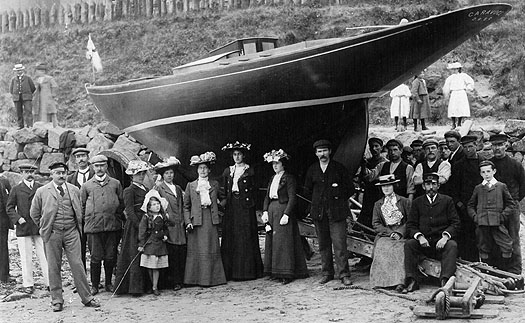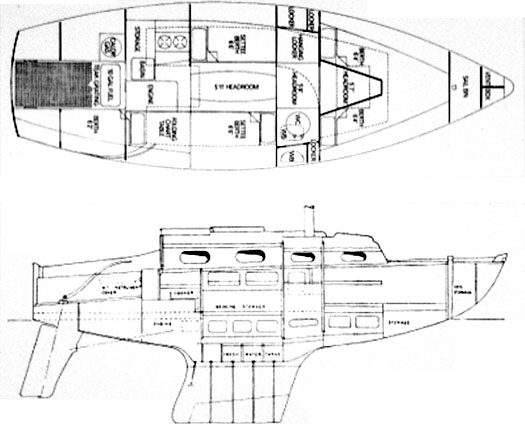#sydneyhobart – Christmas partying is on hold for top ex-Pat sailor Gordon Maguire as he and his crew make the final preparations to defend their place as champions in the premier offshore event in the Southern Hemisphere, the annual Rolex Sydney-Hobart Race.
Since its inauguration in 1945, the 628 mile classic to Tasmania across the challenging Bass Strait has started every year on St Stephens Day. However, in the early events, going off on the thrash to Hobart was considered an integral part of the Christmas festivities – it wasn't unknown for crews to be still partying even as they raced down Sydney Harbour towards open water.
But these days, with an elite lineup next Wednesday of some of the greatest offshore racing boats in the world, it is incumbent on all crews to be hyper-fit and well able for anything the sea can throw at them. If you're not - as has been shown in some of the storm-battered stagings of this great race - the result could be fatalities.
The worst storm of all came in the 1998 race, and the helicopter vids of that would test the offshore racing enthusiasm of even the keenest hardcase viewer. It's quite something to witness 80ft plus Maxis racing along like over-pressed dinghies out in the open water of the Bass Strait. But when you see one of these biggies leap out of the top of a wave and crash into the sea beyond with the huge rig shuddering like a leaf, then you get some idea of what the Sydney-Hobart mystique is all about.
For anyone prone to seasickness, Christmas dinner the day before might be no more than boiled whitefish and mashed potatoes. And out there in the bash southward down the coast of New South Wales, it's a rough world in every sense, with sympathy is in short supply. Last year one of the participants was the famous American vintage 48-footer Carina, built 1969. Having won the 2010 Bermuda Race, she then won her class in the 2011 Fastnet Race and placed fifth overall, an extraordinary achivement. So then the junior members of the crew simply sailed her out to Sydney straight across the Atlantic and the Pacific in time for the 2011 Hobart Race. When the senior crew members joined up, they hadn't been offshore since the Fastnet, and weren't as battle-hardened as the young toughs. So on the second night, slugging into a southerly buster, some very distinguished American yachtsmen were not at all well. Sympathy? No chance. The heartless young Turks simply let the world know that "The Roar of the Dinosaur was Heard Across the Valley of the Lee Rail..... "
For Gordon Maguire and the crew of the 63ft Loki, as defending champions they've everything to lose next week. But the boat is in top form – they lead the points table in the current Australian offshore championship - and with Maguire as sailing master, owner Stephen Ainsworth has one very special talent.
When Loki won the race last year, it was Ainsworth's 14th attempt. But Gordon Maguire won at his very first shot, back in 1991 when he was helming, with Harold Cudmore as boat captain, aboard the 41ft Atara. She was part of the three boat Irish team that stormed Australian sailing to win the Southern Cross series, which culminated in the Hobart race where the Cudmore/Maguire victory sealed the team win.
For next Wednesday's start, the forecast is for fresh sou'easterlies initially, then going east and even northeast before a new westerly sets in late Friday. With plenty of wind expected in the mixture, this pattern suggests that one of the hundred footers – there are four of them in the race – might get to Hobart in a new record time.
As all the biggies are owned and sailed by tough cookies sent out by Central Casting to be the very personification of over-the-top Australian exuberance, the battle of the giants for line honours inevitably draws the initial headlines, and it has added Irish interest as Offaly-born Adrienne Cahalan is navigator (her 21st Sydney-Hobart) on one of the most fancied hundred footers, Wild Oats. But the Tattersall Cup for the overall IRC victor is one of Australia's most revered sporting trophies, and as the big boat brouhaha settles, all attention in Hobart will focus on who is coming up the Derwent towards the finish with a chance of snatching the lead.
When Loki was confirmed as overall winner by 50 minutes in the last days of 2011, the real party started, and Gordon Maguire was ceremonially thrown into the harbour. He didn't mind that at all. He soon texted the folks at home to tell them that the water in Hobart was nowhere near as cold as the water up at Lambay had been back in August 2011, when he'd to go over the side to clear a lobster pot line from the propellers of his father Neville's motor-cruiser.
MORE CLASSIC BOATS FROM PORTRUSH
Our story last week about the Howth 17 Deilginis, built by James Kelly of Portrush in 1907 and restored this year with a new deck by Rui Ferreira of Ballydehob, has rung the bell for classic boat enthusiasts. That fine north coast sailor Robin Ruddock (who restored Wallace Clark's 36ft yawl Wild Goose after she'd suffered the indignity of spending a month under water at the mouth of the River Bann) plays a key role in keeping the Kelly memory alive, for there's no boat building at all these day in Portrush.
But when he was at his busiest, between the 1890s and the 1930s, James Kelly made Portrush a remarkable centre for the master shipwright's art and craft. Initially, he set out to build Drontheims. those elegant double-ended clinker-built 26 footers which were derived from boats imported from the Norwegian port of Trondheim, and were developed along the north coast as multi-purpose vessels. As most of them were built at Greencastle in Donegal, they became known as the Greencastle yawls, but other builders right along the north coast produced their own local variants, and James Kelly was so good at it that he soon had Portrush rivalling Greencastle as a boat-building centre.
But his reputation soon spread beyond the Drontheims, and during the 1890s he started building yachts, two of the most noted being the 9-tonner Saiph in 1897, and the 15-tonner Yucca in 1898. They were both designed by their owner, Howard Sinclair, a Belfast doctor who was an early cruising pioneer – in 1896 he was the first winner of the Challenge Cup of the Cruising Club (later the Royal Cruising Club) for a round Ireland venture with his 5-tonner Brenda, built by Hilditch of Carrickfergus. He was awarded the cup again in both 1896 and '97, for cruises to the Outer Hebrides and the Orkneys with Saiph and Yucca.
James Kelly cheerfully admitted that there was much better money in yacht building than in the construction of fishing boats, but he kept the fishing boat side of his business going, albeit on the back burner. By the early 1900s, however, he was right up there with the leading yacht builders in Ireland, and two of the new Dublin Bay 21s came out of the Kelly yard in 1903-04, Garavoge and Oola.
Thanks to Hugh McGrattan of Portrush, we have this eloquent photo of Garavoge just before her launch in 1903. There is an entire universe in this portrait of the elegant yacht and the crowd about her, with the owner and his friends, and the rightly proud workforce and their friends, all basking in the goodwill at the height of the Edwardian era. And the new Mylne-designed boat looks marvellous – if anyone ever asks you what a classic counter stern should really look like, you couldn't do better than this.
In her long career, one of Garavoge's owners was Gordon Campbell, Lord Glenavy – he was a real mover and shaker in Dublin Bay sailing as he was also active in the Water Wags and the Mermaids, and in 1934 it was his suggestion which led eventually to the Dublin Bay 24 class.
His son was Patrick Campbell the humorist and TV personality, who wrote of sailing in Garavoge – his account of returning from Wicklow Regatta in fog is a gem. When he was told in 1978 that the Twenty-Ones were still active and that Garavoge was still with them, he expressed surprise, saying he thought that by that time "the better bits of Garavaoge would have long since been turned into a dog kennel, or at the most optimistic level, a sturdy home for hens".
With the remains of the seven boats of the Dublin Bay Twenty-One class now mouldering in a farmyard in County Wicklow, Campbell's drollery has become all too true. After he'd seen the photo last week of the Kelly-built 1907 classic Deiliginis so beautifully restored, Robin Ruddock asked what had become of Garavoge. It would have been too cruel to tell him.

Launching day for the Dublin Bay Twenty-One Garavoge at Portrush in 1903. The builder James Kelly is believed to be beside the rudder. Photo courtesy Hugh McGrattan
THE YACHT DESIGNER IN THE CELLAR
My appreciation here a fortnight ago of the late Mike Balmforth and his remarkable career in many branches of the marine industry has started a line of chat in some nautical forums about the T24, T27 and T31. It was one of Mike's first jobs in the boat business, building these performance cruisers with Chris Perfect in Chichester, and mention of the marque has revealed a network of Guy Thomson fans.
Guy Thompson was a leading East Anglian offshore racing enthusiast during the 1940s, 50s and 60s who worked for the Bank of England at their massive headquarters in Threadneedle Street. But he was also a very talented and innovative amateur yacht designer, so much so that a succession of boats he designed for himself – all called Calliope – were always in the EAORA prize list. Thus it's perhaps not strictly true to say that he worked for the Bank of England. He was employed by them. But his real work was down in the cellars, in an unused room he discovered which, over the years, he turned into a proper little secret yacht design office.
We shouldn't be surprised by this – after all, Kenneth Grahame, for many years the Secretary of the Bank of England, also found the time to write the children's classic The Wind in the Willows.
Nevertheless, Guy Thompson's parallel career as a part-time yacht designer was in a league of its own, and when he retired from the Bank, he left behind this secret room stacked to the ceilings with yacht designs and drawings.
Maybe he was too much of a free-thinker to have functioned as a professional designer. As it was, his unique position allowed him to be way ahead of the posse, and in the 1960s when noted East Anglian dinghy racer Dick Pitcher (he was an ace in the Flyng Dutchman) decided he wanted a small performance cruiser, he went to Guy Thompson.
Pitcher's specification was for five berths, full standing headroom, excellent all round performance, and all within 24ft LOA. The result was a little boat called Goosander with which Pitcher won everything about him in 1967, and soon the production version, the T24, was on sale.
As the plans show, there was so much good sense and innovative thinking in the T24 that it's a pity Guy Thompson wasn't designing full time – many yacht designs at this period were dull and unimaginative in the extreme. But the T24 hit the button for those who could think outside the box, and one of the first in Ireland was Kilderkin for Lance McMullen of Dun Laoghaire. His previous boat had been the 36ft ex-6 Metre Rainbow, yet his new much smaller boat was an improvement in almost every way.
Sadly, in the 1960s some of the new GRP production boats were built with wooden decks and coachroofs on the fiberglass hull, and the T24 was one of them. It didn't take long before the clashing behavioural characteristics of the two materials caused problems, and a later owner of Kilderkin recalls her as leaking along much of the hull/deck join.
But like all T24 owners, he fondly recalls her gallant performance, particularly to windward in a breeze. When you think of what some of the boring standard boats of the 1960s were like, you can appreciate why the astonishing little T24 was like a breath of fresh air. And our friends on the forum assure us that a reasonably able amateur handyman with time available can fix those deck leaks.

The boat designed in a cellar in the Bank of England. Guy Thompson's T 24 had the accommodation and performance of many boats half as big again. And don't forget if someone is taking a photo of your boat, always sit down - otherwise she'll look even smaller than she is already

If you want to see how five berths, full standing headroom and a scintillating performance can be fitted into a hull just 24ft LOA, take the time to study these plans of the T24.































































